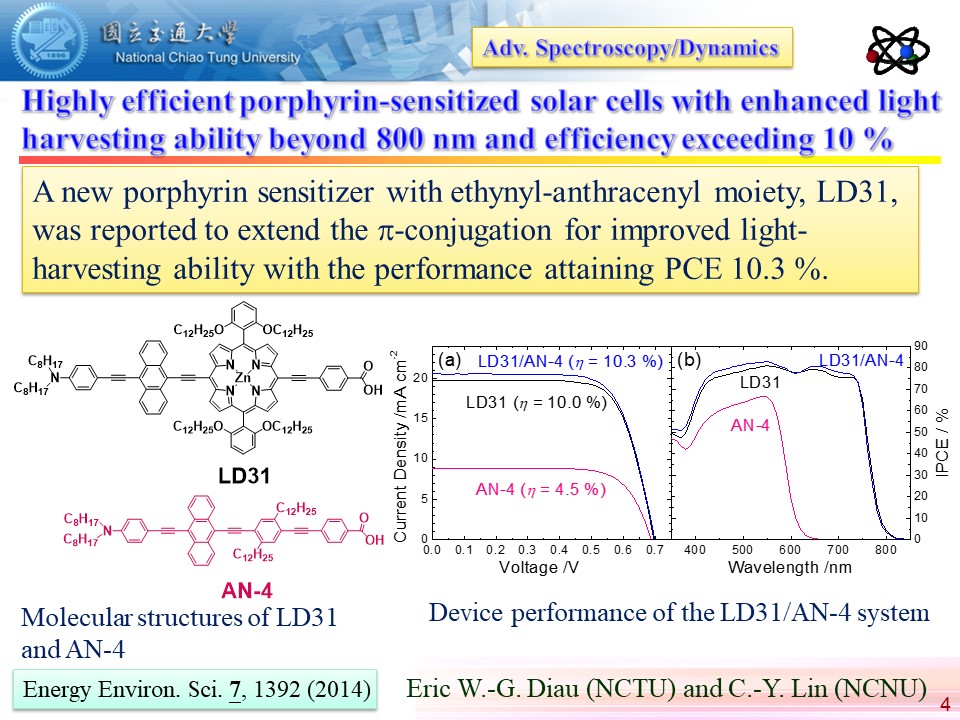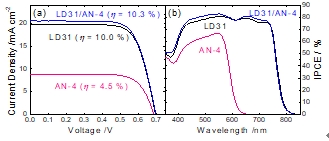



Femtosecond Infrared Transient Absorption Dynamics of Benzimidazole-based Ruthenium Complexes on TiO2 Films for Dye-sensitized Solar Cells

By means of femtosecond infrared transient absorption spectral technique, we observed interfacial electron transfer dynamics for a series of benzimidazole-based heteroleptic ruthenium dyes sensitized on TiO2 thin films. RD dyes substituted with fluorine atoms and/or thiophene units in the benzimidazole ligands showed an effect to retard the 3MLCT electron injection compared to that of the non-substituted RD5 dye. Acceleration of the BET process was observed for the RD5 dye, and both fluoro- and thiophene-substituted dyes were found to retard the BET kinetics significantly. The observed kinetics of the 3MLCT electron injection for all RD dyes can be well simulated via Marcus theory.
* H. Y. Hsu, C. W. Cheng, W. K. Hwang, Y. P. Lee and E. W. G. Diau, “Femtosecond Infrared Transient Absorption Dynamics of Benzimidazole-based Ruthenium Complexes on TiO2 Films for Dye-sensitized Solar Cells”, J. Phys. Chem. C 118, 16904 (2014).
Femtosecond Excitonic Relaxation Dynamics of Perovskite on Mesoporous Films of Al2O3 and NiO Nanoparticles

The excitonic relaxation dynamics of perovskite adsorbed on mesoporous thin films of Al2O3 and NiO were investigated with femtosecond optical gating of photoluminescence (PL) via up-conversion. The temporal profiles of emission were described satisfactorily with a composite consecutive kinetic model and three transient components representing one hot and two cold excitonic relaxations. When the NiO film was employed, we observed an extent of relaxation proceeding through the non-emissive surface state larger than through the direct electronic relaxation channel, which quenches the PL intensity more effectively than on the Al2O3 film. We conclude that perovskite is an effective hole carrier in a p-type electrode for NiO-based perovskite solar cells showing great performance.
* H. Y. Hsu, C. Y. Wang, A. Fathi, J. W. Shiu, C. C. Chung, P. S. Shen, T. F. Guo, P. Chen, Y. P. Lee and E. W. G. Diau, “Femtosecond Excitonic Relaxation Dynamics of Perovskite on Mesoporous Films of Al2O3 and NiO Nanoparticles”, Angew. Chem. Int. Ed. 53, 9339 (2014).
Nanofabrication of Uniform and Stabilizer-free Self-assembled Platinum Monolayers as Counter Electrodes for Dye-sensitized Solar Cells

We report a two-step dip-coating approach to fabricate self-assembled monolayers of Pt nanocrystals (SAM-Pt) uniformly deposited on a TCO surface. The DSSC devices using Z907 dye as a photosensitizer and the CE prepared according to this SAM-Pt approach attained notable photovoltaic performance comparable to those fabricated with a conventional thermal decomposition method or a cyclic electro-deposition method under the same experimental conditions. We emphasize that the SAM-Pt films feature a clean surface, uniform morphology, narrow distribution of size, small Pt loading and great catalytic activity; the present approach is hence not only suitable for DSSC but also applicable for many other energy-related applications that require platinum as an efficient catalyst.
* L. L. Li, H. H. Wu, C. H. Tsai and E. W. G. Diau, “Nanofabrication of Uniform and Stabilizer-free Self-assembled Platinum Monolayers as Counter Electrodes for Dye-sensitized Solar Cells”, NPG Asia Materials 6, e118 (2014).
Highly Efficient Porphyrin-sensitized Solar Cells with Enhanced Light harvesting Ability Beyond 800 nm and Efficiency Exceeding 10 %

A new porphyrin sensitizer, LD31, was designed based on a donor-π-acceptor structure, in which an ethynyl-anthracenyl moiety was inserted between the dioctylaminophenyl group and the porphyrin core in order to extend the π-conjugation of the dye for improved light-harvesting ability. The device made of LD31 exhibited panchromatic spectral feature covering the whole visible region and further extending over 800 nm. When combined with an organic dye (AN-4), the performance of the LD31/AN-4 co-sensitized device attained JSC/mA cm-2 = 20.3, VOC/mV = 704, FF = 0.72, and the overall efficiency of power conversion η = 10.3 %.
*C. L. Wang, J. Y. Hu, C. H. Wu, H. H. Kuo, Y. C. Chang, Z. J. Lan, H. P. Wu, E. W. G. Diau and C. Y. Lin, “Highly Efficient Porphyrin-Sensitized Solar Cells with Enhanced Light Harvesting Ability Beyond 800 nm and Efficiency Exceeding 10 %”, Energy Environ. Sci. 7, 1392 (2014).